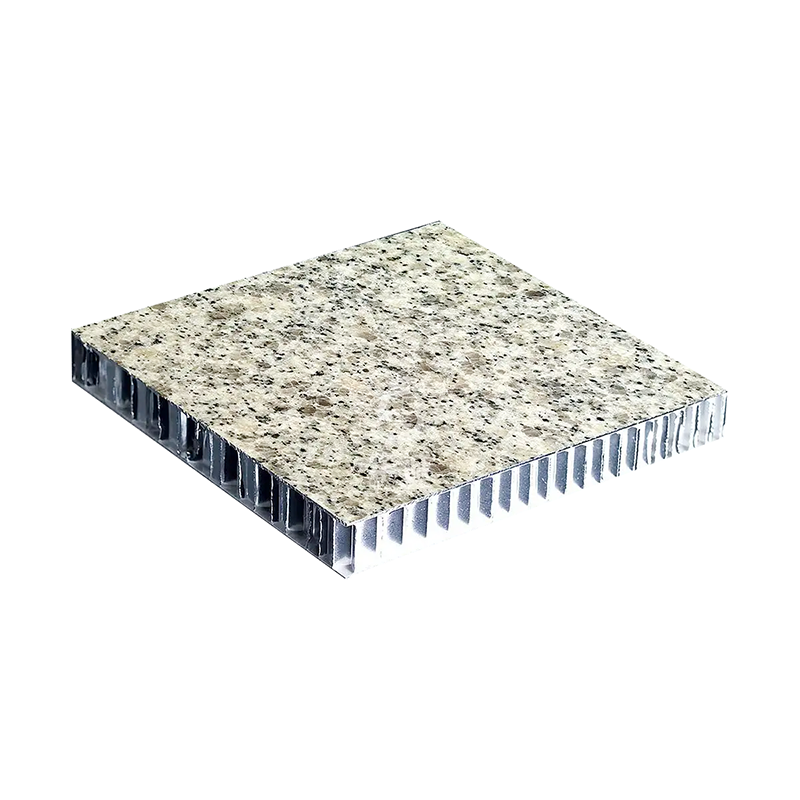Views: 217 Author: Julong Publish Time: 2023-03-27 Origin: aluminum panel systems manufacturer








Stone aluminum honeycomb panels are widely used in buildings, vehicles, and ships, and they are very popular in the decoration industry today. This article will primarily assist you in comprehending stone aluminum honeycomb panels from three perspectives: structure, application, and classification.
Stone aluminum honeycomb panels are generally made of 3-5 mm of stone and 10–25 mm of aluminum honeycomb panels, which are bonded together by a special adhesive. For the exterior curtain wall, the stone thickness of the aluminum honeycomb panel is recommended to be 4-5mm, and the thickness of the aluminum honeycomb panel is not less than 25mm. For the interior wall, the stone thickness of the aluminum honeycomb panel is recommended to be 3–4 mm, and the thickness of the aluminum honeycomb panel is 15mm. For the interior ceiling, the stone thickness of the stone aluminum honeycomb panel is recommended to be 3–4 mm, and the thickness of the aluminum honeycomb panel is 15-20mm. For the floor panel, the stone thickness of the aluminum honeycomb panel is recommended to be 3–4 mm, and the thickness of the aluminum honeycomb panel is 15-20mm. The thickness of stone for a stone aluminum honeycomb panel is 5-8 mm, and the thickness of an aluminum honeycomb panel is 10-15 mm.
A stone aluminum honeycomb panel has the characteristics of being lightweight, low in radiation pollution, saving stone material, having a large panel size, etc. It can be used for the ceiling, curtain wall, interior wall, floor, etc. Therefore, its more and more widely used in the decoration of buildings, vehicles, ships, etc.
Compared with aluminum veneer, box-type honeycomb aluminum plate can be up to 1500 mm by 4500 mm, which is because the plate itself is a composite material and the internal aluminum honeycomb provides a guarantee for the plate itself to bear its weight so that the plate itself does not need to add any reinforcement. An ordinary aluminum veneer in a width greater than 1m or length greater than 2m must be added behind the stiffening ribs. The stiffening ribs need to be welded on the back of the board, because the thermal expansion coefficient of the stiffening ribs and the board itself is not the same, after several times of hot and cold changes, the front of the board will appear uneven phenomenon. And this phenomenon usually starts to appear about half a year to a year after the completion of the project.
An aluminum veneer is a single-layer product with relatively simple processing and strong modeling ability but poor precision. A honeycomb panel is a composite product with weaker processing speed and ability but with guaranteed precision.
The box-type honeycomb aluminum panel adopted is the buckle cover system; there are two systems of exposed glue seam and hidden glue seam available. The system fully considers the influence of thermal expansion and contraction on the panel itself; the panel is free to expand and contract in all four directions, effectively avoiding the influence of temperature stress on the flatness of the panel.
Ordinary single-layer aluminum panels only have an exposed adhesive seam system, and because the installation is fixed to the keel with the installation code, there is no suitable space to release the temperature stress, resulting in the board surface being prone to warping.
A honeycomb panel is a composite panel with the advantages of light quality, high strength, good flatness, a large board surface, easy installation, easy maintenance, good environmental protection, being reusable, and excellent resistance to thermal expansion and contraction.
An aluminum veneer is an ordinary non-composite sheet; compared with a honeycomb panel, it does not have the above advantages. But in comparison, the cost of 3MM thick aluminum veneer is generally 15-20% lower than 25MM honeycomb board. Because of the self-weight and molding reasons, the building is less used than 4 mm of thick aluminum veneer, and the thickness of the aluminum veneer cost difference with the honeycomb products is only about 5%.